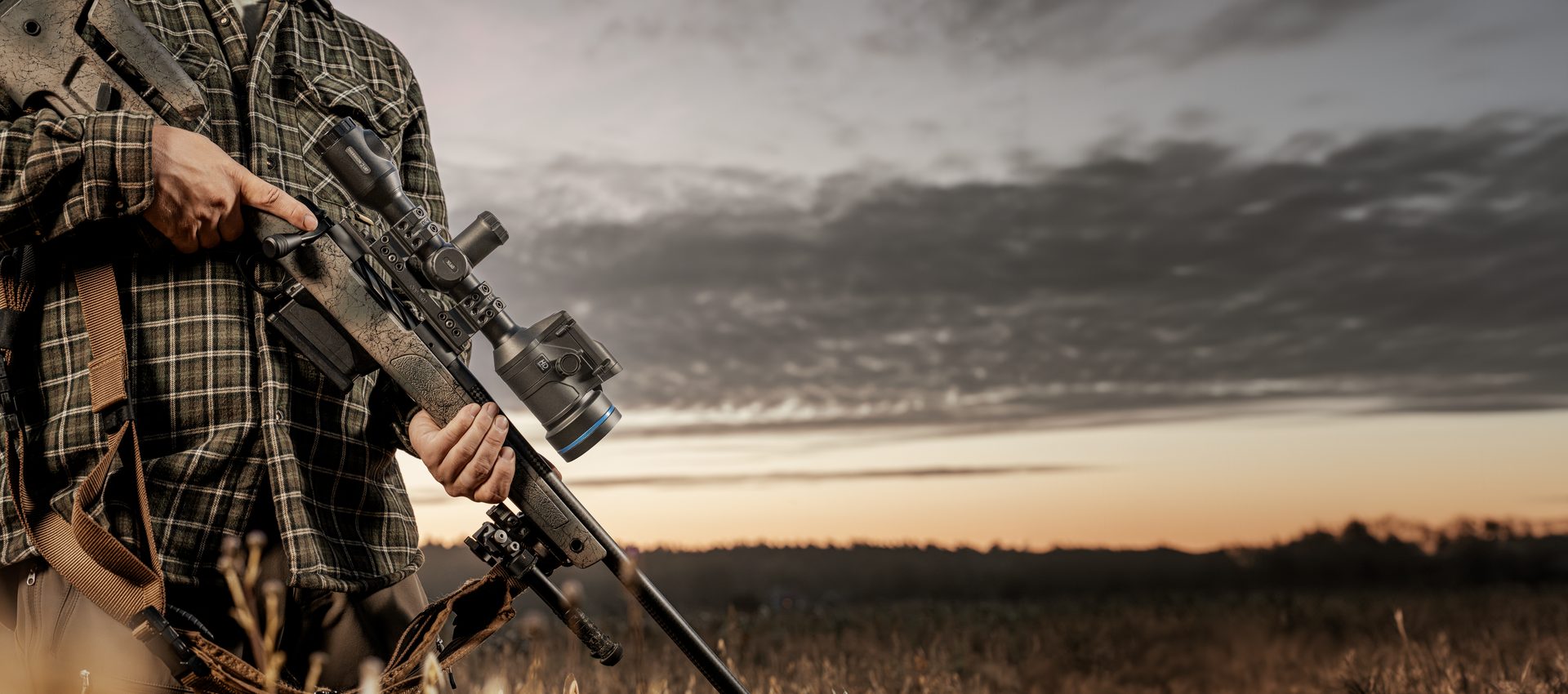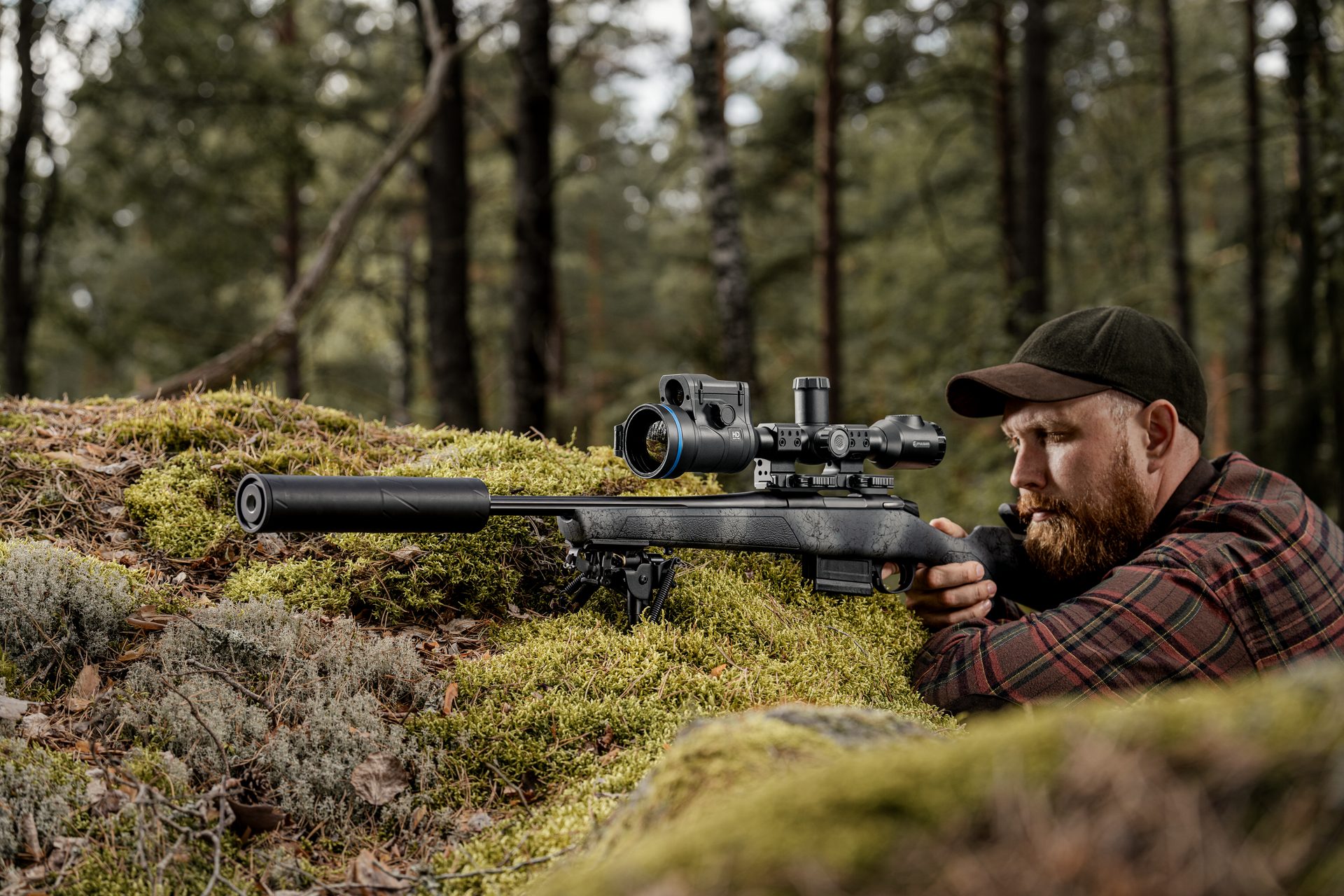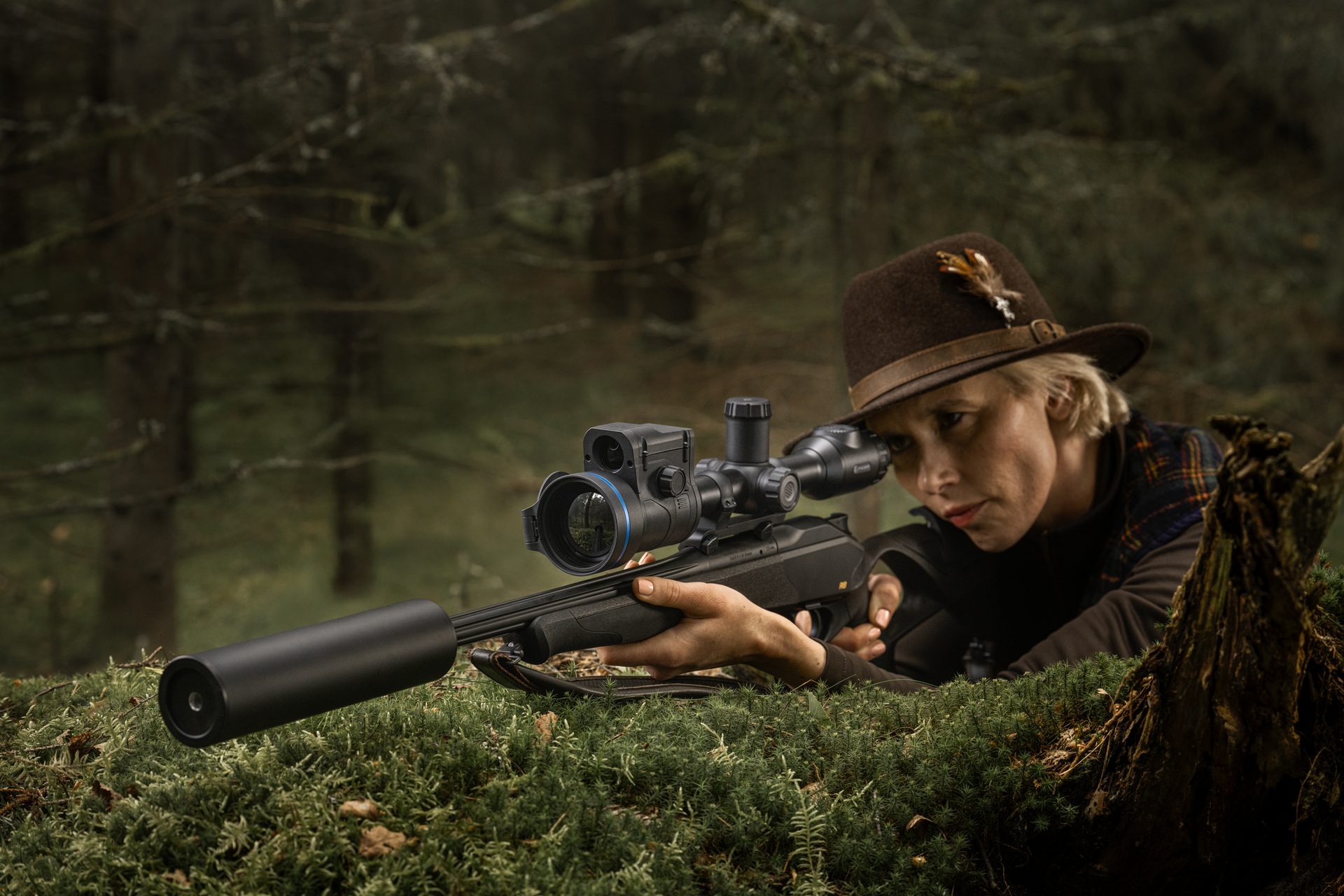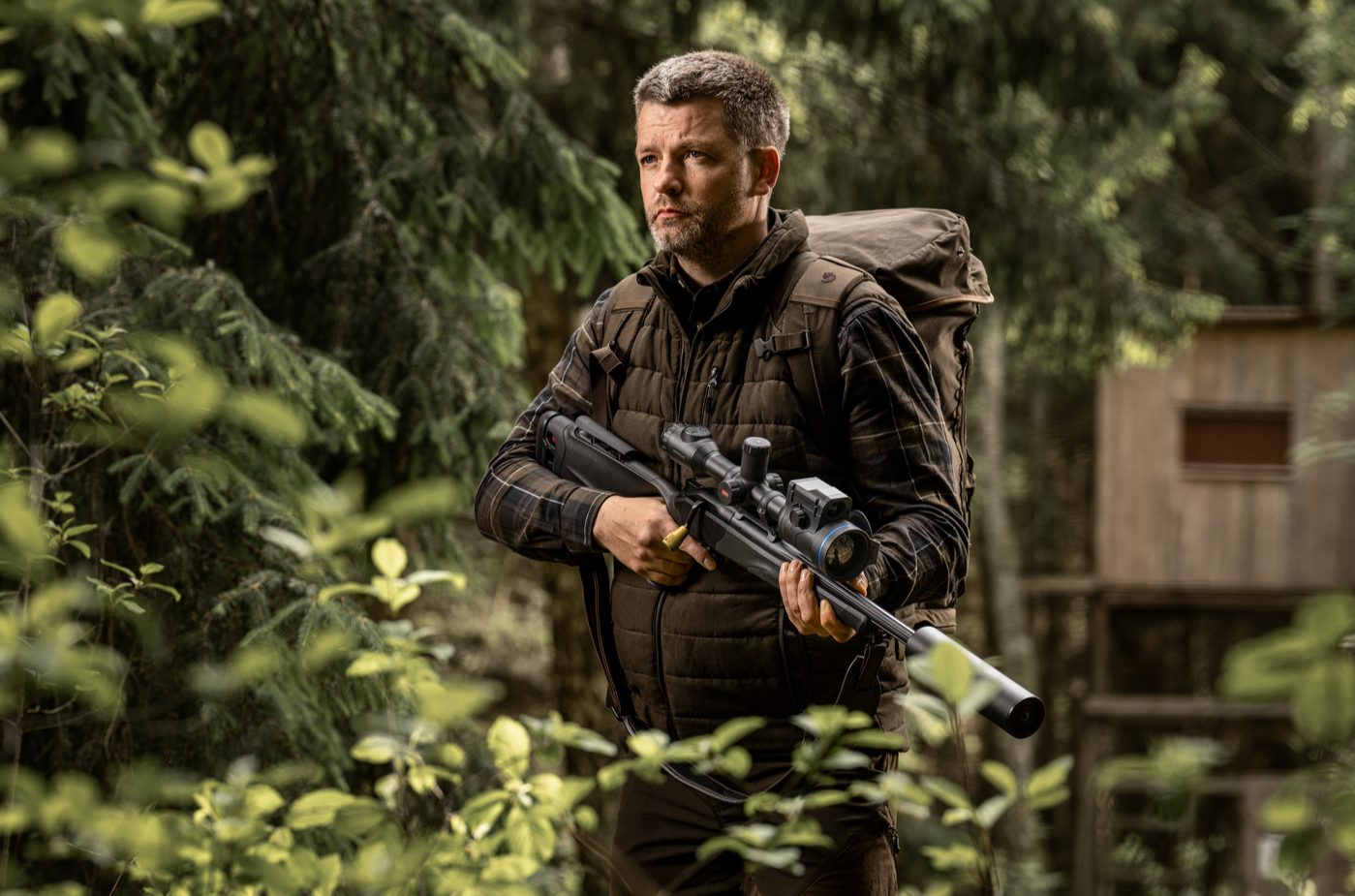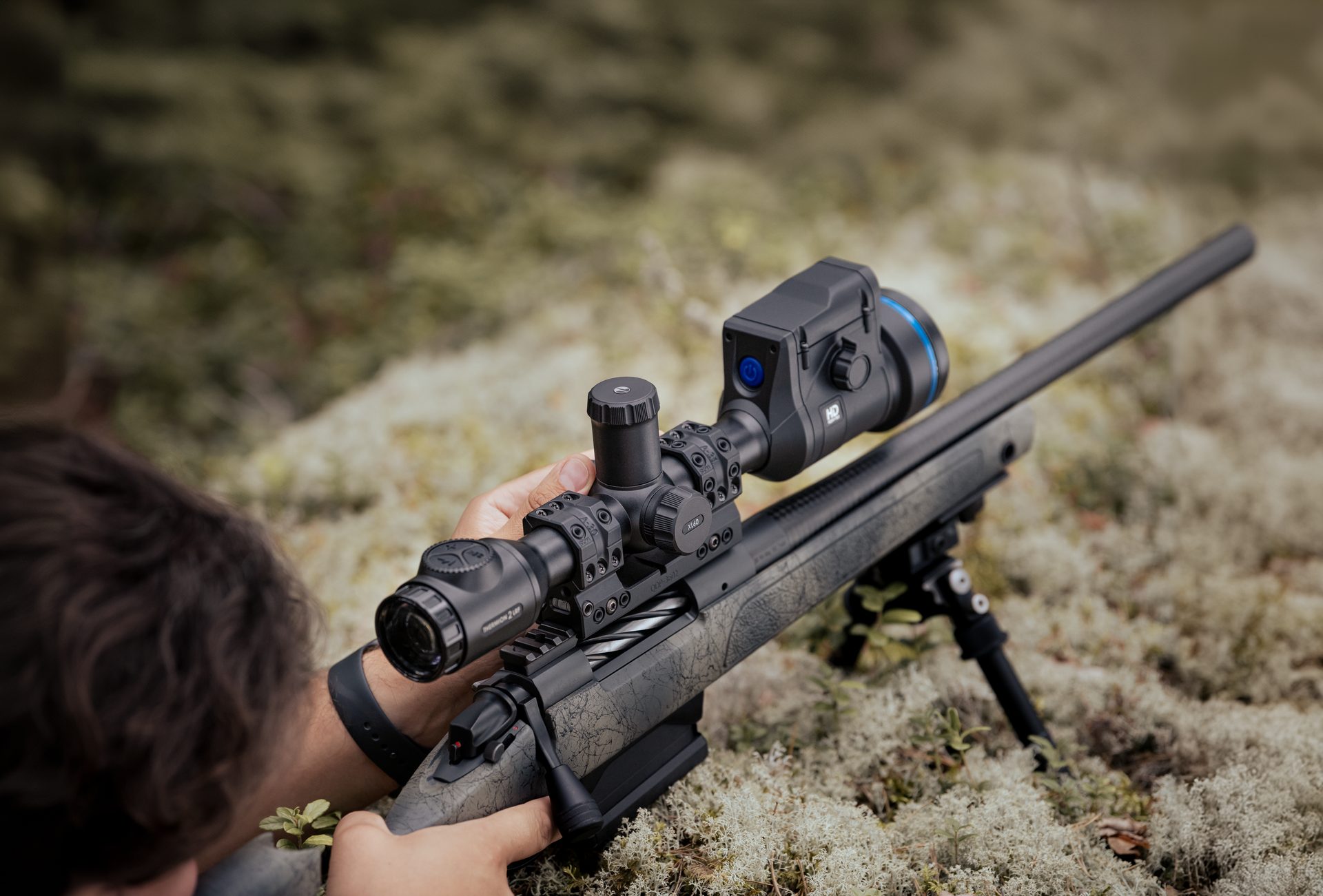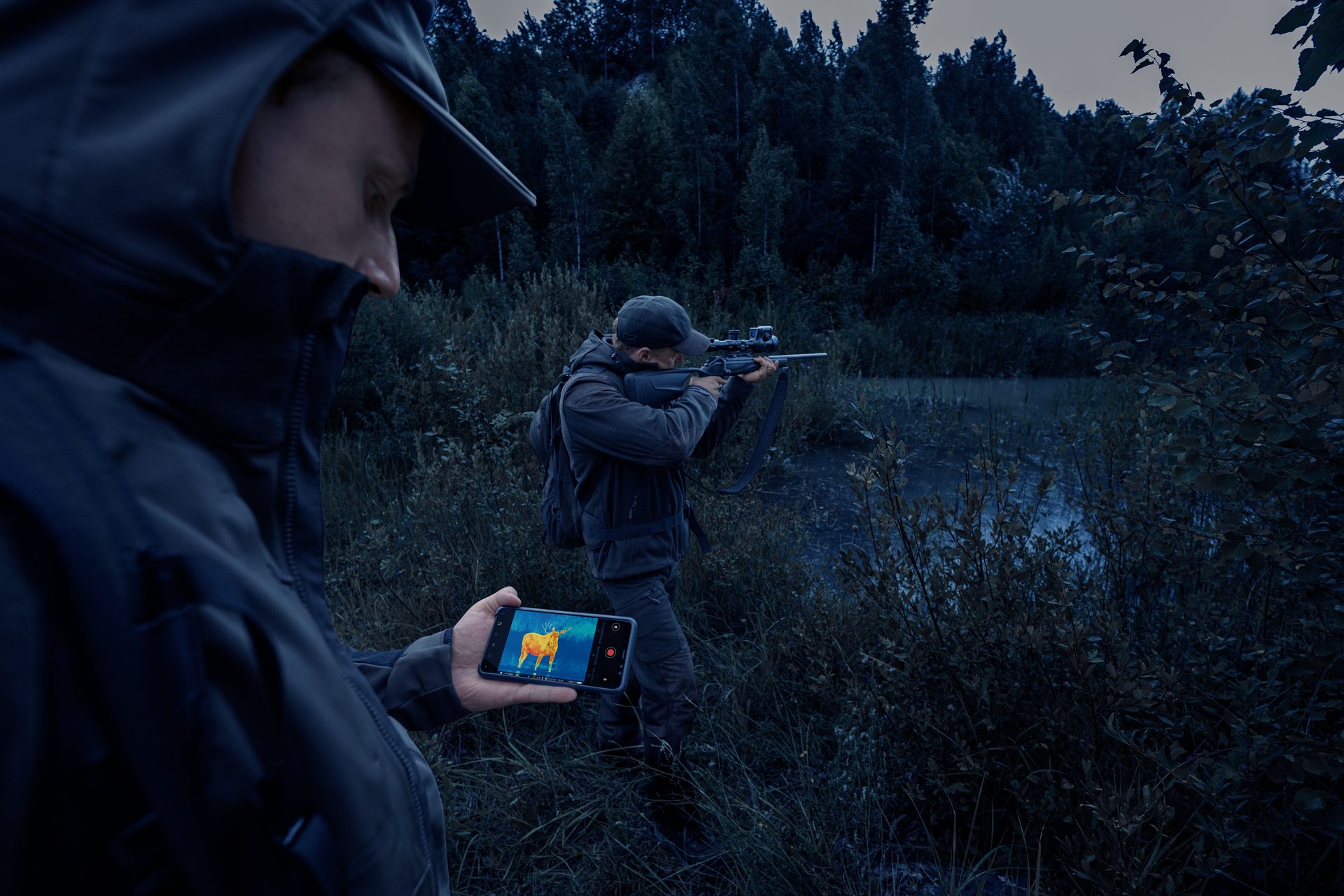Expert Contributor:
Erik Bjaelkvall
Quick Review:
Thermal optics have become game-changers for predator hunters, and Pulsar’s thermals have since long been considered to be at the top of the food chain. Whether you’re calling coyotes under the moonlight in the Midwest or scanning wide Texas fields, there’s a solution for you.
The Pulsar Thermion 2 LRF 60 line comes in three models: the Thermion 2 LRF XL60, the Thermion 2 LRF XG60, and the Thermion 2 LRF XP60. I’ve used all models in various night hunting situations, and here’s how they compare in short:
- Thermion 2 LRF XG60: With its solid 4x base magnification, the Thermion 2 LRF XG60 is the best option for long-range shooting precision.
It’s ideal for hunting coyotes and varmints, with a highly informative image even when magnified up to 32 times.
- Thermion 2 LRF XP60: With its <25 mK NETD, Thermion 2 LRF XP60 is best for hunting in harsher weather conditions.
Has the highest thermal sensitivity, which is ideal for low visibility: you’ll spot the smallest details, even in humid conditions.
- Thermion 2 LRF XL60: The flagship model, Thermion 2 LRF XL60, with its HD resolution sensor performs well on targets big and small, near and far. A low 2.5x base magnification offers the best field of view.
This is the most expensive option, but it also ticks all of the boxes I’m looking for.
Dive deeper: Explore Thermion 2 LRF 60 line in detail
Best Thermal Scope For Coyote Hunting Review
All of the Pulsar Thermion 2 LRF 60 riflescopes are designed for hunting small, fast moving targets at extended ranges. They are all very effective for coyote and predator control, but there are specific features and differences between each model. Read on and learn which model suits your needs and budget best.
Thermion 2 LRF XL60: Best HD Thermal Scope for Coyote Hunting
The XL60 is Pulsar’s flagship model, equipped with a 1024×768 HD resolution thermal sensor and a pixel pitch of 12 microns. It’s the best choice for coyote hunters who prefer excellent image detail and contrast, achieved through a thermal sensitivity (sNETD) below 20 millikelvin.
The built-in laser rangefinder (LRF) adds practical value for hunters who need precise range estimation, particularly when scanning over large open fields. On top of that, in conjunction with Pulsar’s Stream Vision Ballistics app, you get accurate on-screen calculations for your long-range shooting.
The magnification range is 2.5 to 20×. This is the lowest base magnification available in the Thermion line, and offers the best field of view (FOV), which suits both close-range scanning and long-range engagements.
Erik’s tip:
Many hunters underestimate the importance of a large FOV, but my experience is that when hunting coyotes, most shots are done with fairly low magnification.
Key specifications:
- Sensor resolution: 1024×768
- Pixel pitch: 12 µm
- Thermal sensitvity (sNETD): <20 mK
- Magnification range: 2.5-20x
- Rangefinder: Yes
- Use case: Mixed terrain with HD clarity
Decision shortcut: The XL60 is recommended for experienced coyote hunters who simply want the best, prioritize HD image resolution and clarity, accurate target identification, and are operating in a mixed terrain.
Read more: Three hunters on Thermion 2 LRF XL60
Get your Thermion 2 LRF XL60 now: Find a local dealer
 Thermion 2 LRF XG60: Best Thermal Scope for Long-Range Coyte Hunting
Thermion 2 LRF XG60: Best Thermal Scope for Long-Range Coyte Hunting
The XG60 features a 640×480 resolution sensor with a finer 12-micron pixel pitch. It has a higher base magnification of 4 to 32×, making it a strong option for long-range shooting. The XG60 is perfect for hunting those smaller and fast-moving coyotes at long distances, with precision.
The integrated laser rangefinder and extended detection range (over 3,000 yards) make it well-suited for hunting in wide-open environments.
While the sensor resolution is lower than the XL60, the increased magnification and reach give the XG60 a distinct advantage in flat terrain where visibility is key.
The XG60 model also has the smallest click value for enhanced zeroing precision.
Decision shortcut: The XG60 is a strong choice for coyote hunters covering large fields or open plains who want magnification and long-range capabilities, with built-in rangefinding.
Key specifications:
- Sensor resolution: 640х480
- Pixel pitch: 12 µm
- Thermal sensitvity (sNETD): <20 mK
- Magnification range: 4-32x
- Rangefinder: Yes
- Use case: Vast areas that require magnification
Read more: Hunter reviews the Pulsar Thermion 2 LRF XG60
Get your Thermion 2 LRF XG60 now: Find a local dealer
 Thermion 2 LRF XP60: Best Thermal Scope for Hunting Coyotes in High Humidity
Thermion 2 LRF XP60: Best Thermal Scope for Hunting Coyotes in High Humidity
The XP60 offers the same 640×480 resolution as the XG60 but with a slightly larger 17-micron pixel pitch. What sets it apart is its exceptional thermal sensitivity, rated under 18 millikelvin.
This results in superior image clarity in poor thermal contrast conditions such as fog, humidity, or cold environments. Its 3 to 24× magnification is versatile, and the built-in laser rangefinder adds practicality for distance shooting.
Decision shortcut: The XP60 is recommended for coyote hunters operating in high-humidity or cold-weather conditions who prioritize thermal sensitivity over sensor resolution.
Key specifications:
- Sensor resolution: 640х480
- Pixel pitch: 17 µm
- Thermal sensitvity (sNETD): <18 mK
- Magnification range: 3-24x
- Rangefinder: Yes
- Use case: Coyote hunting in humid environments
Get your Thermion 2 LRF XP60 now: Find a local dealer
Key Features to look in Coyote Hunting Thermal Scopes
When hunting fast-moving predators like coyotes, choosing the right thermal scope means understanding the key features that directly impact detection range, image clarity, and shot precision.
Here’s a brief explanation of the components involved, what to look out for, and why it will matter to you.
Thermal Sensor Resolution
Higher resolution (e.g., 640×480 or 1024×768) provides sharper, more detailed images, crucial for distinguishing coyotes from other wildlife at longer ranges.
Lower resolutions (like 384×288) may suffice for shorter distances, but 640×480 or higher is a minimum for a modern, professional-level hunter.
Thermal Sensitivity – sNETD (mK)
Short for Noise Equivalent Temperature Difference, NETD measured in milliKelvin. S stands for System, meaning the NETD is measured for the entire device.
The lower the number, the better, as it enhances a thermal riflescope’s ability to produce high-quality images in low-visibility scenarios.
In coyote hunting, a thermal scope with sNETD <20 mK or lower will outperform others when heat signatures are weak – especially in conditions like fog, humidity, or cold mornings.
Dive deeper: Learn all about sNETD
Pixel Pitch (µm)
Pixel pitch refers to the distance between adjacent pixels on a thermal sensor. A lower pixel pitch, like 12 microns, creates a better quality image – ideal for identifying coyotes at range.
Higher pixel pitch, such as 17 microns, offers slightly less quality but more detail, especially in high-humidity scenarios.
For coyote hunting, your choice of pixel pitch will depend on where you plan to hunt: if you need to see quality image, go for higher resolution and lower pixel pitch. If you need to see clearly in tough situations – higher pixel pitch is your friend.
Explore further: Understanding pixel pitch
Objective lens
The 60 mm lenses are made of germanium or chalcogenide and capture the smallest heat signals. Plus, they’re optimized for long-range hunting, which is especially helpful when controlling the coyote population, as you rarely get too close to them.
Display Screen Resolution
Micro-OLED 2560×2560. This screen, located in the ocular, is your eye’s best friend, and offers high resolution, excellent contrast, fast response times, and a wide color gamut.
This display communicates what the thermal sensor sees. The higher display resolution, the better image you get. Plus, your eye gets less tired even after long coyote hunting sessions.
Refresh Rate (Hz)
All Pulsar Thermion offer 50 Hz, which is enough even for fast moving targets. A lower refresh rate will cause lag in the image which will make you miss, especially at longer range.
Magnification & Field of View (FOV)
This is the balance between target acquisition and long-range identification. A wide FOV aids in tracking fast-moving coyotes, and increases the all-around situational awareness, but sometimes you really need to zoom in with high magnification to identify a specific object.
Detection Range
Defines how far a thermal scope can detect, recognize, and identify a target (e.g., a coyote) based on sensor resolution, lens quality, and environmental conditions.
Battery Life & Power Solutions
The Thermion 2 is powered by both an internal and an external battery, both of which are rechargeable. Embossed markings on the replaceable battery allow for quick and confident battery swaps, even in complete darkness.
There’s also a USB-C port, so you can run an external power pack, for those extended outings when you have multiple coyotes to deal with.
Durability & Weather Resistance
When choosing a riflescope for coyote hunting, durability is a must, as it will surely get lots of use and, often, in unfavorable conditions.
All Pulsar Thermions are engineered to withstand the recoil of heavy calibers, and are rated for 12-gauge shotguns and .375 H&H rifles, so you’re safe to use it with your favorite rifle for predator hunting.
Weather and dust have been accounted for as well, with IPX7 submersion waterproof ratings.
Ergonomics & User Interface
The Thermions are designed to be used in the field, and can be operated in complete darkness with ease. The user interface is easy to learn, and works both for beginners who only want the basics, to more advanced users who want to tweak every detail.
Ergonomics is easy to overlook, but don’t underestimate the power of it – coyotes are fast, and when aiming for one, your reaction needs to be even faster. You surely don’t want to be fumbling over settings and seeing your target disappear.
Remote Control
Each Thermion 2 LRF 60 model is provided with a Pulsar Bluetooth remote control, offering hands-off operation of all digital features and settings.
Attach this remote control to your rifle stock to make swift changes, without having to reach up to the riflescope – it makes target acquisition faster and more comfortable.
Additional Features
All of the Thermion 2 LRF 60 mm series offer a bunch of additional features:
- Built-in rangefinder and on-screen ballistic calculations for improved accuracy,
- Photo and video recording capabilities,
- Wi-Fi and Bluetooth connection to external apps,
- Best-in-class 65 mm eye relief for extended comfort and compatibility with high calibers.
Erik’s overview:
As you can understand, all of the components that make a great thermal riflescope have to match and work together, and nothing is stronger than its weakest link.
Pulsar’s thermal riflescopes use premium components, and are protected behind IPX7 waterproofing, ensuring the scope remains fully operational even in unpredictable weather conditions, such as heavy rain or accidental drops in water while navigating rugged terrain, guaranteeing reliability and performance in the harshest environments.
Related: How to Choose The Right Thermal Scope For Hunting
Explore further: About the Thermion 2 LRF line
Thermion 2 LRF 60 Model Comparison for Coyote Hunting
The table below highlights the key technical differences between the three Pulsar Thermion 2 LRF 60 models – XL60, XG60, and XP60 – for coyote hunting use cases. These attributes directly impact detection range, thermal clarity, and field performance in mixed environments.
| Thermion 2 LRF XL60 | Thermion 2 LRF XG60 | Thermion 2 LRF XP60 | |
|---|---|---|---|
| Sensor resolution | 1024×768 @ 12 µm | 640×480 @ 12 µm | 640 x 480 @ 17 µm |
| sNETD | <35 | <40 | <25 |
| Lens | F60/1.1 | F60/1.1 | F60/1.1 |
| Magnification range, x | 2.5 – 20 | 4 – 32 | 3 – 24 |
| FOV degrees / m@100m | 11.7 | 7.3 | 10.4 |
| Detection range, m | 2800 | 2800 | 2000 |
| Eye relief, mm | 65 | 65 | 65 |
| Display, type / resolution, pixel | Micro-OLED 2560×2560 | Micro-OLED 2560×2560 | Micro-OLED 2560×2560 |
| Click value (H/V), mm@100m | 16/16 | 10/10 | 14/14 |
For a deeper comparison of all Pulsar devices (including monoculars and non-LRF scopes), visit the official Pulsar device comparison tool.
Maximizing Your Thermal Scope for Coyote Hunting Success
So you decided to get one of the thermal riflescopes suggested above, and the coyotes are starting to howl. Great, now let’s maximize its performance by optimizing the scope settings for predator hunting success.
Ocular
For more efficient predator control, make sure to adjust the eyepiece diopter adjustment ring, so that you can read the screen clearly. Without this easy adjustment, nothing’s going to look sharp.
Focus
Thermals use larger apertures (f/1.1), allowing more light to pass through the lens. Make sure that you adjust the focus so that you have a clear view on the coyote you’re aiming at.
You will have to readjust the focus as the distance changes, or your image quality and definition will decrease.
Erik’s tip: Sometimes I zoom in on the target (or the expected range) and fine-tune the focus to maximize the definition, then zoom back to my overall setting.
Color Palette
Use White-hot or Black-hot for general scanning, as they highlight coyotes clearly against cooler backgrounds. Green can be nice too.
Contrast/Brightness
Adjust contrast to enhance coyote heat signatures against terrain. Avoid over-bright settings that can wash out details.
Picture-in-Picture (PiP)
The PiP function allows you to see both a magnified image in a particular dialog box and the main image. You can adjust the magnification level, but don’t overdo it.
Zeroing
It’s pretty simple: if your scope isn’t zeroed properly, you’re not going to hit. Make sure you zero your scope properly at 100 yards. Use a heat source (e.g., hand warmer) as a target for precise calibration.
Get a quality mount so that everything’s attached to your rig. Read the manual, or check the video below to learn the process.
Reticles
Select a reticle suited for quick acquisition, like a simple crosshair or duplex, to avoid cluttering the thermal image. Switch to a Mil-Dot or BDC reticle and use the laser rangefinder and Ballistics software for long-range shooting.
Also, make sure you choose a color that’s clearly visible in all conditions. Don’t choose a red reticle and use red hot, for instance – this will cause you trouble when finding your aim at a coyote.
Remote Control
The wireless remote control duplicates the functions of turning off the device, turning off the display, calibration, digital zoom, rangefinder control, switching amplification levels, and it allows navigation through the menu.
Please make sure you use it, as it makes adjustments a lot easier and faster! Place it on your rifle, close to where you have your trigger finger.
Erik’s tip:
Familiarize yourself with the short and long press and scroll wheel functionality well in advance, so you’re fast and intuitive when on the field.
Battery Packs
Bring enough batteries or use an external battery pack. Coyote hunting is generally more productive in colder periods but remember that lower temperatures drain the batteries faster.
Calibration Mode
Calibration eliminates image flaws (such as vertical bars, phantom images, grainy field of view, etc.) by equalizing the thermal sensor background temperature.
Use the SA mode (semi-automatic) setting for control, calibrate manually as you see fit. You can use the A Mode (automatic), but be aware it may interrupt tracking predators at critical moments.
Thermal Monocular
Use a handheld thermal scanner (Pulsar Axion, Telos or Merger) for scanning to reduce neck strain and fatigue.
Explore the full range of Pulsar thermal monoculars
Related: Thermal Monocular vs Binoculars: Which Should You Choose?
Firmware Updates
Make sure you have the latest firmware on your Thermion.
Not sure how to download the latest firmware? Find the step-by-step instructions below.
Troubleshooting
Something’s not working? Pulsar has an online manual for your device that will guide you through the most common issues.
Erik’s tip:
I would recommend that you practice adjusting settings in different lighting and weather conditions to familiarize yourself with the scope’s response. With the right settings, your thermal will give you a much better image quality. You don’t have to overdo it, but you need to manage the basics and with time you’ll enjoy your investment much more.
Thermal Scope vs. Night Vision: Which is Best for Coyote Hunting and why?
This is a subject that can be debated until forever, so to see how thermal and night vision compare for coyote detection, let’s begin by looking at the facts and how these two technologies work.
Fundamental Differences
In short, thermal imaging detects heat signatures emitted by coyotes and displays them as white-hot, black-hot, or color-coded images. Thermals work in complete darkness, fog, smoke, or light cover, making it ideal for open terrain hunts with no moonlight.
Digital Night Vision amplifies ambient light (like starlight or moonlight), or uses IR illumination to create a visible image. It’s best suited for static setups in moonlit clearings, where budget and positive target ID are priorities.
Erik’s tip:
When choosing between a thermal scope and a night vision scope for coyote hunting, the decision depends on your hunting conditions, budget, and other specific needs.
If you’re scanning large fields under cloud cover with no ambient light, thermal gives you the edge. But for close-range calling setups with moderate moonlight, night vision can be more cost-effective and clearer for confirming coyote behavior.
Read More: Thermal and Night Vision Devices: All You Need To Know
Why Thermal Scopes Outperform Night Vision for Coyote Hunting
In my opinion, and I don’t even have to be brave to say that this is the general consensus among hunters, thermal scopes are far superior for coyote hunting due to their ability to detect heat signatures in any lighting condition, through light cover, and at long ranges.
They’re particularly effective in open terrain or during pitch-black nights, which are common for coyote hunting. Simply put: there’s no hiding from a thermal.
Pulsar tip: If you’re hunting in wide-open terrain under low or no moonlight, thermal is the superior choice. It detects movement and heat where night vision simply can’t.
That said, if budget is a constraint, a hybrid solution with a thermal monocular for scanning, combined with a digital night vision riflescope will be a good choice for closer ranges and clearer identification, especially in areas with some ambient light. In short, detect with your thermal monocular, and identify with the night vision riflescope
Erik’s warning:
Beware that coyotes are cautious, and may detect some types of IR illuminators needed to enhance the night vision scope.
Another limitation of night vision is that you can’t see through foliage or fog. Unlike thermal, you need a clear line of sight. It can’t penetrate fog, smoke, or light brush like thermal imaging can. But when visibility is good and ambient light is available, night vision often delivers sharper, more detailed images – ideal for confirming target ID at closer ranges
My experience is that people looking to explore nighttime hunting initially get a night vision scope, mainly due to budget reasons. But eventually they end up with a thermal – quite often sooner than later!
Important Note: Check national and local regulations, as some countries and states restrict thermal or night vision use for hunting.
Conclusion: Making an Informed Decision for Your Coyote Hunting Needs
Choosing the best Pulsar thermal scope for coyote hunting in 2025 means understanding how sensor resolution, thermal sensitivity, magnification, and field of view align with your terrain and hunting style. The Thermion 2 LRF XL60 stands out for its unmatched HD clarity and versatility in mixed terrain. If long-range precision is your priority, the XG60 delivers superior magnification and detection reach. For those battling fog, humidity, or cold, the XP60 excels with exceptional thermal sensitivity.
Each of these models is engineered with durable, hunter-focused features, like integrated rangefinders, long battery life, and ergonomic controls, that ensure performance in real-world conditions.
No matter which you choose, you’re investing in field-tested reliability and cutting-edge thermal imaging. Take time to assess your typical hunting environment, distance needs, and visibility challenges to select the right tool.
Explore Pulsar’s Thermion 2 LRF 60 series to elevate your coyote hunting success.
Frequently Asked Questions
What is the best thermal scope for the money?
The Pulsar Thermion 2 LRF XP60 offers exceptional value for hunters seeking high performance without paying for ultra-HD resolution. With a sensitive 640×480 sensor, excellent image processing, and long detection range, it balances price and feature, making it one of the most cost-effective tools for serious coyote hunters.
Can you hunt coyotes with a thermal scope?
Yes, thermal scopes are highly effective for hunting coyotes, especially in low-light conditions. They detect heat signatures, allowing you to spot coyotes at night or through dense brush, fog, or snow – scenarios where traditional optics or night vision often fall short.
What magnification do I need for coyote hunting?
For most coyote hunting scenarios, a base magnification between 2x and 4x provides the ideal balance of target clarity and wide field of view. Higher magnification – like the 4x base of the XG60 – is ideal for open fields or long-range setups, while lower magnification works best in closer or wooded environments.
Is thermal better than night vision for coyote hunting?
Yes, thermal is generally better than night vision for coyote hunting. Thermal scopes work in complete darkness and don’t require ambient light. They also perform better in variable weather and can detect camouflaged or motionless coyotes, making them a more versatile and reliable choice in real-world conditions.
About the Expert
Erik Bjaelkvall is a former Arctic Ranger, now a competitive practical shooter, seasoned hunter, and gear expert with decades of field experience.
Operating out of Sweden, Erik has extensively tested thermal imaging equipment across diverse environments – from open plains to rugged mountains, through snow, fog, and sun.
Before purchasing any night or thermal vision device, please make sure you adhere to the local legislation and only use it when it is allowed. Our ambassadors come from various countries and travel a lot, which allows them to test different devices. We do not encourage or support the illegal use of our devices in any events. If you wish to learn more about export and sales restriction policy, please visit the following link: Export and Sales Restriction Policy.
